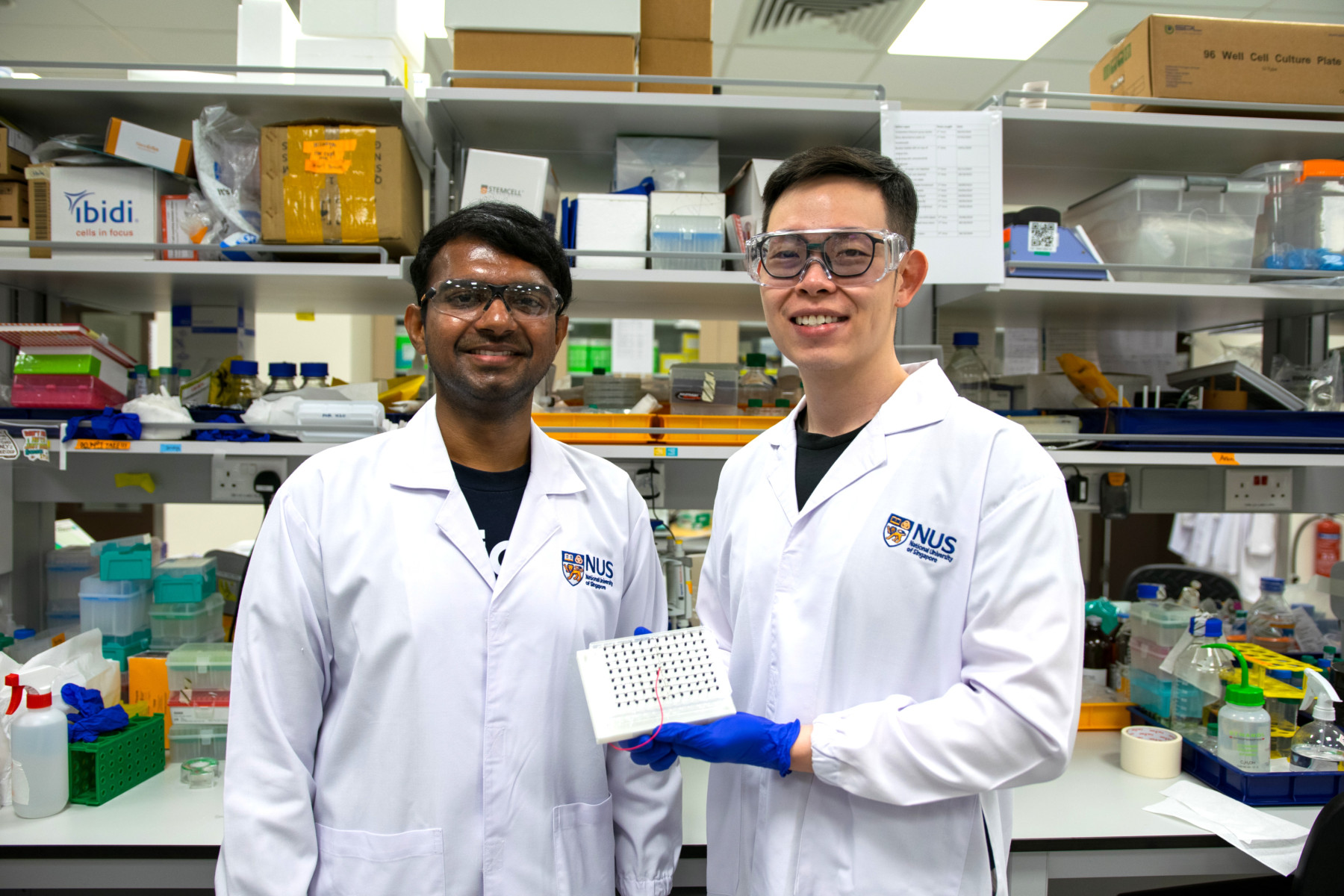## Level Up Your Immune System: Researchers Unleash Gene Editing Powerhouse
Imagine a future where your very own cells become living weapons against disease. No, this isn’t the plot of a sci-fi blockbuster, it’s the groundbreaking reality being explored by NUS researchers.

They’ve just cracked the code on a revolutionary gene delivery technology that could transform the way we treat everything from cancer to autoimmune disorders. Think of it like a digital upgrade for your immune system, equipping your cells with the power to fight back against even the toughest foes.

The Promise of Personalized Medicine
Personalized medicine, the tailoring of medical treatment to an individual’s unique genetic makeup, lifestyle, and environment, holds immense promise for revolutionizing healthcare. This approach aims to move away from the “one-size-fits-all” model, delivering more precise and effective therapies with fewer side effects. At the heart of this revolution lies the ability to manipulate genes within our own cells to treat disease.
One of the most exciting frontiers in personalized medicine is the field of immunotherapy, which harnesses the power of our own immune system to fight cancer and other diseases. A prime example is CAR-T cell therapy, a groundbreaking treatment that involves genetically engineering a patient’s T cells (a type of immune cell) to recognize and destroy cancer cells. While CAR-T therapy has shown remarkable success in treating certain blood cancers, its widespread adoption faces significant challenges.
Accessibility Challenges
One of the main hurdles hindering the accessibility of CAR-T therapy is its high cost. The manufacturing process for CAR-T cells is complex and labor-intensive, requiring specialized equipment and expertise. As a result, a single CAR-T cell infusion can cost hundreds of thousands of dollars, placing it out of reach for many patients.
Another challenge is the limited availability of manufacturing facilities capable of producing CAR-T cells at scale. This shortage can lead to long wait times for patients and restrict access to the therapy in certain regions.
NExT: A Potential Game-Changer for CAR-T Manufacturing
Researchers at the National University of Singapore (NUS) have developed a groundbreaking technology called Nanostraw Electro-actuated Transfection (NExT) that could potentially address these accessibility challenges and usher in a new era of personalized medicine. NExT is a scalable, non-viral method for delivering genetic material into human immune cells.
Lowering Costs and Production Complexity
Traditional methods for delivering genetic material into immune cells, such as viral vectors and bulk electroporation, often involve complex procedures, specialized equipment, and multiple steps. NExT, on the other hand, simplifies the process significantly. By utilizing a dense forest of tiny hollow nanostructures called nanostraws, NExT can deliver biomolecules such as mRNA or CRISPR/Cas9 complexes directly into cells with high efficiency and minimal disruption.
This streamlined approach has the potential to significantly reduce manufacturing costs and simplify the production process for CAR-T cells and other cell therapies. The scalability of NExT also means that it can be readily adapted for large-scale production, addressing the issue of limited manufacturing capacity.
Expanding Access to Life-Saving Therapies
By lowering the cost and complexity of manufacturing CAR-T cells, NExT has the potential to make this life-saving therapy more accessible to a wider range of patients. This is particularly important for individuals in developing countries who may not have access to the high-cost treatments available in more affluent nations.
The potential impact of NExT extends beyond CAR-T therapy. This versatile technology can be applied to a range of other cell-based therapies, enabling the development of more innovative and effective treatments for a variety of diseases.
Beyond CAR-T: NExT’s Role in Expanding Immunotherapy
NExT’s ability to efficiently deliver genetic material into diverse immune cell types opens up exciting possibilities for expanding the scope of immunotherapy beyond traditional CAR-T approaches.
Engineering Diverse Immune Cell Types
While CAR-T cells have achieved remarkable success in treating certain blood cancers, they are not effective against all types of cancers. NExT’s ability to transfect a wide range of immune cells, including gamma-delta T cells, T regulatory cells, dendritic cells, macrophages, natural killer cells, and neutrophils, allows researchers to explore the potential of these alternative cell types for cancer immunotherapy. Each of these cell types possesses unique functionalities that could be harnessed to target and destroy cancer cells.
Tailoring Treatments for Specific Diseases
NExT’s versatility extends beyond cancer immunotherapy. This technology can be used to engineer immune cells for treating a wide range of diseases, including autoimmune disorders, infectious diseases, and even genetic diseases. By precisely modifying the genetic makeup of immune cells, researchers can tailor treatments to specific patient needs and disease profiles.
NExT’s Impact on the Bioengineering Landscape
The development of NExT represents a significant breakthrough in the field of bioengineering, with the potential to accelerate research and development in a wide range of areas.
Accelerated Research and Development
NExT’s efficiency and ease of use make it a valuable tool for researchers investigating new gene therapies and cell-based treatments. The ability to quickly and reliably deliver genetic material into a variety of cell types will accelerate the pace of discovery and innovation in the field of bioengineering.
Empowering Personalized Medicine
NExT is a key enabler of personalized medicine, empowering healthcare providers to tailor treatments to individual patients based on their unique genetic makeup and disease profiles. By making gene therapy more accessible and affordable, NExT has the potential to transform healthcare and improve the lives of countless individuals.
Conclusion
Revolutionizing Gene Delivery: A Breakthrough in Immunotherapy
In a groundbreaking achievement, researchers from the National University of Singapore (NUS) have developed a pioneering gene delivery technology for immune cells, as reported in News-Medical. This innovative breakthrough, which has the potential to revolutionize the field of immunotherapy, enables the precise and efficient delivery of genes to immune cells, paving the way for new treatments for various diseases. The technology, which leverages a novel combination of biomaterials and nanoparticles, allows for the targeted activation of immune cells, thereby amplifying their anti-tumor capabilities.
The significance of this development cannot be overstated. By harnessing the power of gene delivery technology, researchers can now develop more effective treatments for a range of diseases, including cancer, autoimmune disorders, and infectious diseases. This breakthrough has the potential to transform the landscape of immunotherapy, enabling scientists to design more targeted and personalized treatments that can harness the full potential of the immune system. The implications of this technology are far-reaching, with the potential to improve treatment outcomes, reduce side effects, and enhance patient quality of life.
As we look to the future, it is clear that this breakthrough has the potential to unlock new avenues of research and development in the field of immunotherapy. With the ability to precisely deliver genes to immune cells, scientists can now explore new possibilities for treating complex diseases. As we continue to push the boundaries of what is possible, we are reminded of the immense potential that lies at the intersection of science and medicine. With this breakthrough, we take a significant step forward in the pursuit of a healthier, more resilient future – one where the power of gene delivery technology transforms the lives of countless individuals worldwide.